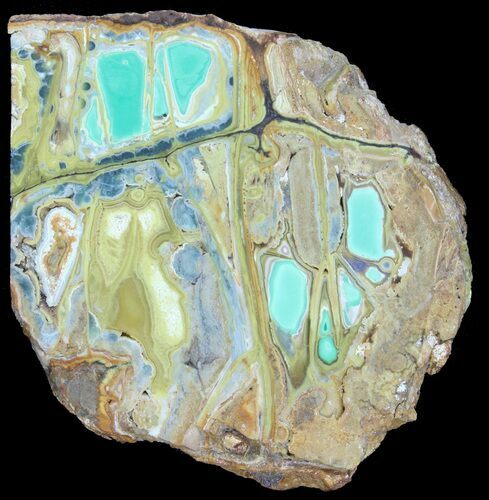This Specimen has been sold.
4.1" Slab Of Clay Canyon Variscite - Old Collection Stock
This is slab of rare and very collectable Variscite from the Little Green Monster Mine mine in Clay Canyon of Utah. The material was collected between 1937 and 1940 and almost none has been collected since. Most of it, and likely these slabs were sold out of the Smithsonian gift shop, then the National Museum.
The slab is 4.1" wide and .65" thick, it has been polished on both sides and includes the secondary mineral Crandallite (yellow banding) and Wardite (blue banding)
More information about the Clay Canyon Variscite can be found on Mindat at the link below:
Clay Canyon & the Little Green Monster Variscite Mine
Variscite is a secondary mineral formed by direct deposition from phosphate-bearing water that has reacted with aluminium-rich rocks in a near-surface environment. It occurs as fine-grained masses in nodules, cavity fillings, and crusts. Variscite often contains white veins of the calcium aluminium phosphate mineral crandallite. It is sometimes confused with turquoise; however, variscite is usually greener in color.
The slab is 4.1" wide and .65" thick, it has been polished on both sides and includes the secondary mineral Crandallite (yellow banding) and Wardite (blue banding)
More information about the Clay Canyon Variscite can be found on Mindat at the link below:
Clay Canyon & the Little Green Monster Variscite Mine
Variscite is a secondary mineral formed by direct deposition from phosphate-bearing water that has reacted with aluminium-rich rocks in a near-surface environment. It occurs as fine-grained masses in nodules, cavity fillings, and crusts. Variscite often contains white veins of the calcium aluminium phosphate mineral crandallite. It is sometimes confused with turquoise; however, variscite is usually greener in color.
SPECIES
Variscite, Crandallite, Wardite
LOCATION
Little Green Monster Mine, Clay Canyon, Utah
SIZE
4.1x3.7", .65" thick
CATEGORY
ITEM
#39160
 Reviews
Reviews














